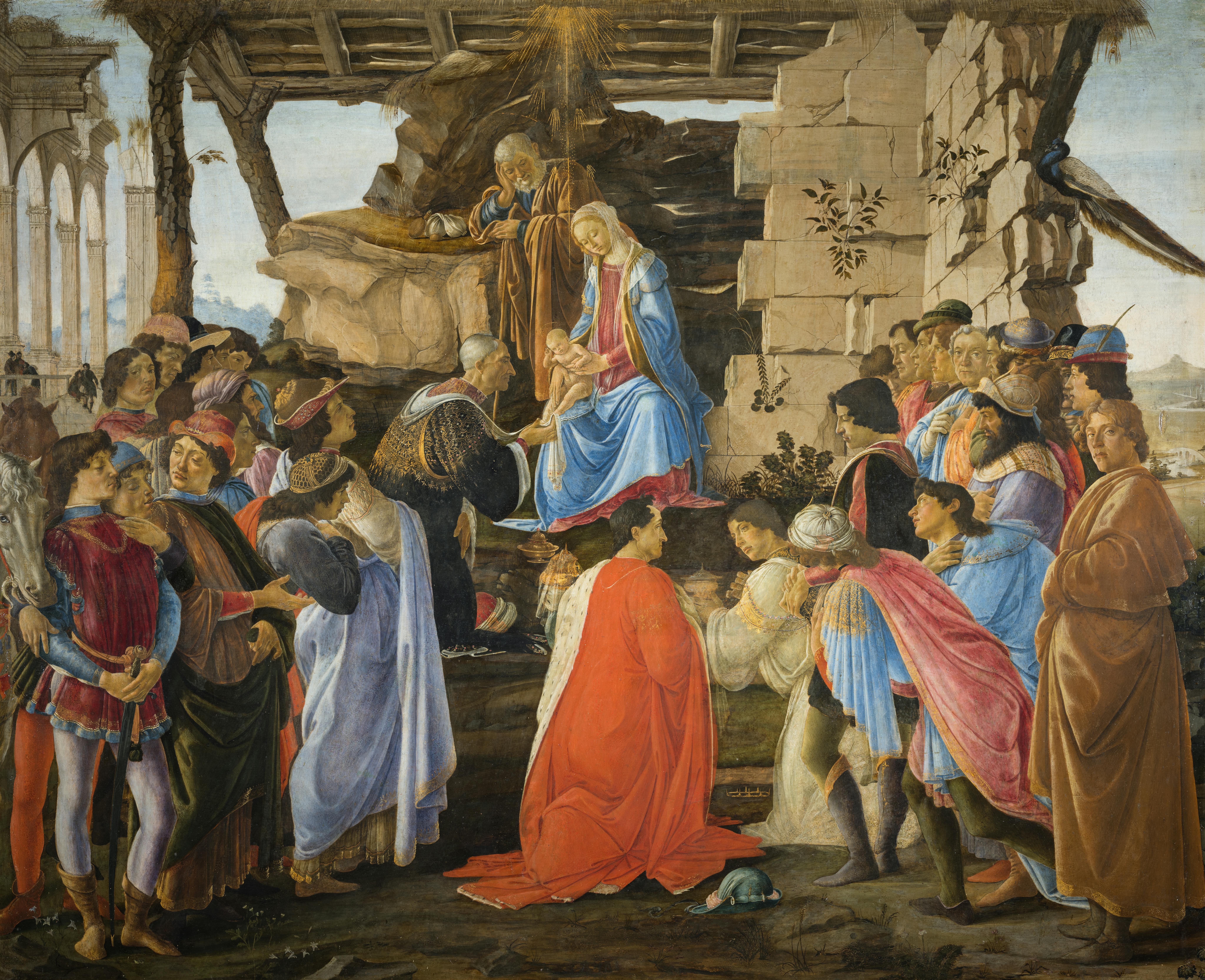Adoration of the Magi
Alessandro Filipepi known as Sandro Botticelli (Florence 1445-1510)
The Gospel theme of the homage of the Three Magi to Baby Jesus is transformed by Sandro Botticelli into a parade of characters from Florentine society in the years of the Medici family's rise to power. Mary with Jesus sits at the center of the scene, under the shooting star that guided the Magi on their journey. Joseph is asleep, as it is written in the account of Matthew the evangelist (2:13), according to which Mary's husband had a vision in a dream that led him to flee to Egypt, thus saving Jesus from Herod.
Baby Jesus is blessing one of the Three Magi kneeling at his feet. According to Giorgio Vasari, the man looks like Cosimo the Elder de' Medici, who died in 1464 at the age of 75. He is depicted with a senile face while dabbing Jesus' feet with his hands veiled by a cloth, a respectful behavior that complies with ancient devotional practices. The other two Magi probably look like Cosimo's sons, Piero the Gouty, cloaked in red and kneeling in the center foreground, and Giovanni, who is standing next to him dressed in white. Like their father Cosimo, both of them were already deceased when the panel was made, the former in 1469 and the latter in 1463.
Other members of the Medici family are believed to be taking part in the scene: Lorenzo the Magnificent, at around twenty-five years of age, is probably the half-face young man with black hair depicted on the right, dressed in black and red, while his younger brother Giuliano is supposed to be the young man with a knight's sword in the foreground on the left.
Sandro Botticelli may also have portrayed himself in the painting as the young blond man on the right who seeks our gaze, a recurring pose for painters' self-portraits.
On the other hand, the patron of the work is the white-haired man, dressed in light blue, in the group on the right, who turns towards us and points to himself to underline his role. He was Gaspare di Zanobi del Lama (1411-1481), an ambitious businessman and agent for the Guild of Cambio. In 1469, he founded a chapel in the Church of Santa Maria Novella dedicated to the Magi and the Epiphany. The choice of the title is to be found in the name of the patron, Gaspar, which also corresponds to one of the three Magi's name. But at the same time, the title was also an homage to the Medici family, as they used to be members of the Compagnia dei Magi and protagonists of the cavalcade that paraded through Florence to celebrate the Epiphany.
The painting overlooked the altar of the Del Lama chapel, set within a sumptuous sculptural frame and surmounted at the top by a fresco of the Nativity of Jesus painted by Botticelli himself, which is still in the church today. The panel with the Adoration of the Magi brought great fame to the master, since it was admired for the variety of poses of the figures and for the extraordinary portraiture skills demonstrated by the painter. Gaspare del Lama, on the other hand, had little luck: convicted of fraud in 1476, he fell into disgrace and died a few years later. The chapel he founded, which passed to others, was abandoned in the third quarter of the 16th century and the painting became property of the Medici family, as in 1587 it appeared in the collection of Don Antonio (1576-1621), son of Grand Duke Francesco I de' Medici and his second wife Bianca Cappello.
The work has been displayed at the Uffizi since 1796, after being found in the Medicean Villa of Poggio Imperiale in Florence.
R. Lightbown, Botticelli. Complete catalogue, Londra 1978, vol. II, pp. 35-37; A. Cecchi, Botticelli, Milano 2008, pp. 136-142; C. Frosinini in Botticelli and Renaissance Florence, a cura di C. Frosinini e R. McGarry, Minneapolis 2022, pp. 176-178
